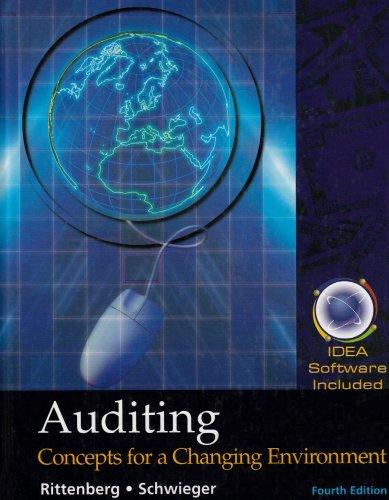You are to sample accounts receivable balances using a classical method. There are 1,500 customers and the
Question:
You are to sample accounts receivable balances using a classical method. There are 1,500 customers and the book value is \($3,000,000.\) The desired risk of incorrect rejection is 5 percent, risk of incorrect acceptance is 20 percent, and tolerable misstatement is \($200,000.\)
Required:
a. Sample size—Calculate the sample size for each of the classical methods if the desired allowance for sampling error is \($140,000,\) and the estimated standard deviation is 1. \($1,531\) for mean-per-unit sampling 2. \($397\) for ratio estimation sampling 3. \($393\) for difference estimation sampling
b. Point estimate and projected misstatement—Without prejudice to your answers in part
a, assume that you confirmed or performed alternative procedures on 64 customer balances having a total book value of \($133,000\) and a total audit value of
\($130,000.\) Calculate the point estimate of the correct value of accounts receivable and projected misstatement using:
1. Mean-per-unit sampling
2. Ratio estimation sampling
3. Difference estimation sampling
4. Non-statistical sampling (sample was selected randomly)
c. In part b, why is the MPU estimate of the difference an understatement and the others an overstatement?
d. Decision interval—You have determined that difference estimation sampling is the most appropriate method to use for evaluation. The achieved precision is \($143,325.\)
1. What is the decision interval?
2. Are these results acceptable? Explain.
3. What is the risk of incorrect rejection? Explain.
e. Allowance for sampling error and precision based on part a above—Using difference estimation sampling:
1. Show how the desired allowance for sampling error of \($140,000\) is determined.
2. Show how the achieved precision of \($143,325\) is calculated. The standard deviation of the sample differences is \($390.
3.\) The achieved precision (\($143,325)\) exceeds the desired allowance for sampling error (\($140,000\).
(a) Calculate the adjusted achieved precision and the related decision interval.
(b) Are these revised sample results acceptable?
(c) What is the risk of incorrect acceptance?
(d) What is the risk of incorrect rejection?
Step by Step Answer:

Auditing Concepts For A Changing Environment With IDEA Software
ISBN: 9780324180237
4th Edition
Authors: Larry E. Rittenberg, Bradley J. Schwieger





